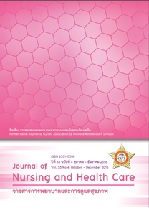แบบจำลองเชิงสาเหตุพฤติกรรมการคุมกำเนิดของสตรีวัยรุ่น A Causal Model of Contraceptive Behavior among Female Adolescents
คำสำคัญ:
แบบจำลองเชิงสาเหตุ พฤติกรรมการคุมกำเนิด สตรีวัยรุ่น A Causal Model, Contraceptive Behavior, Female Adolescentsบทคัดย่อ
การวิจัยเชิงสหสัมพันธ์ครั้งนี้ มีวัตถุประสงค์เพื่อศึกษาปัจจัยที่มีอิทธิพลต่อพฤติกรรมการคุมกำเนิดของสตรี
วัยรุน่ และตรวจสอบความสอดคลอ้ งของแบบจำลองเชิงสาเหตุกับขอ้ มูลเชิงประจักษ ที่พัฒนาขึ้นตามแนวคิดแบบ
จำลองบูรณาการพฤติกรรม (The Integrated Behavioral Model [IBM]) ร่วมกับการทบทวนวรรณกรรม กลุ่ม
ตัวอย่างเป็นนักศึกษาหญิงอาชีวศึกษาที่มีประสบการณ์การมีเพศสัมพันธ์ จำนวน 458 คน คัดเลือกกลุ่มตัวอย่าง
ดว้ ยวิธีการสุม่ แบบหลายขั้นตอน เครื่องมือที่ใชใ้ นการเก็บรวบรวมขอ้ มูลประกอบดว้ ยแบบสอบถามพฤติกรรมการ
คุมกำเนิด และแบบสอบถามปจั จัยที่มีสง่ อิทธิพลพฤติกรรมการคุมกำเนิดของสตรีวัยรุน่ วิเคราะหข์ อ้ มูลพื้นฐานของ
กลุ่มตัวอย่างโดยใช้สถิติเชิงพรรณนา ตรวจสอบความตรงเชิงโครงสร้างและความสอดคล้องของแบบจำลองเชิง
สาเหตุโดยใช้โปรแกรมการวิเคราะห์ข้อมูล Mplus ผลการวิจัยพบว่า แบบจำลองเชิงสาเหตุพฤติกรรมการคุมกำเนิดของสตรีวัยรุ่นมีความสอดคล้องกับข้อมูลเชิงประจักษ์อยู่ในเกณฑ์ดี (x2/ df = 1.54, CFI = .98, TLI = .97, RMSEA = .03, SRMR = .05) แบบจำลองสามารถร่วมกันทำนายพฤติกรรมการคุมกำเนิดของสตรีวัยรุ่นได้ร้อยละ 84 (R2 = .84, p < .001) โดยพบว่าพลังความสามารถของตนเองต่อพฤติกรรมการคุมกำเนิด ความตั้งใจในการคุมกำเนิด และอำนาจความสัมพันธ์ทางเพศมีอิทธิพลทางตรงต่อพฤติกรรมการคุมกำเนิด (β = .38, p < .001, β = .42, p < .001, β = .40, p < .001) การรับรูบ้ รรทัดฐานทางสังคมตอ่ พฤติกรรมการคุมกำเนิด เจตคติตอ่ พฤติกรรมการคุมกำเนิด และพลังความสามารถ ของตนเองต่อพฤติกรรมการคุมกำเนิดมีอิทธิพลทางอ้อมต่อพฤติกรรมการคุมกำเนิด (β = .55, p < .001, β = .08,p < .01, β = .32, p < .001) ข้อเสนอแนะ การพัฒนาโปรแกรมการส่งเสริมพฤติกรรมการคุมกำเนิดสำหรับสตรีวัยรุ่น พยาบาลและบุคลากรทีมสุขภาพควรมุง่ เนน้ การสรา้ งเสริมพลังความสามารถของตนเอง และอำนาจในการควบคุมความสัมพันธ์และความสามารถในการตัดสินใจที่จะเลือกใชวิ้ธีการคุมกำเนิดที่มีประสิทธิภาพและปลอดภัย โดยนำเพื่อน และคูรั่ก/แฟนซึ่งเป็นผู้ที่มีอิทธิพลต่อสตรีวัยรุ่นเข้ามามีส่วนร่วมในกิจกรรมการสร้างเสริมเจตคติ พลังความสามารถของตนเอง และพฤติกรรมการคุมกำเนิดของสตรีวัยรุ่น
The purpose of this research was to study the factors affecting contraceptive behavior among female adolescents in order to verify the consistency of the causal model associations with empirical data. The hypothesized casual model was based on The Integrated Behavior Model (IBM) and literature reviews.The sample consisted of 458 female vocational students. The research instruments used were questionnaires on contraceptive behavior and factors affecting contraceptive behavior among female adolescents. Data were analyzed by descriptive statistical analysis. Data were used to validate the consistency of the structural relationship model by Mplus The findings were as follows: A causal model of contraceptive behavior among female adolescents associations showed congruity with empirical data and were good fit (x2/ df = 1.54, CFI = .98, TLI = .97,RMSEA = .03, SRMR = .05). The model accounted for 84 % of the variance in contraceptive behavior among female adolescents (R2 = .84, p < .001). Personal agency regarding contraceptive behavior,
intention to use contraceptive and power in sexual relationship had significant direct effects on contraceptive behavior among female adolescents (β = .38, p < .001, β = .42, p < .001, β = .40, p <.001). Attitude towards contraception behavior, perceived norms for contraceptive behavior and personal agency regarding contraceptive behavior had significant indirect effects on contraceptive behavior among female adolescents (β = .55, p < .001, β = .08, p < .01, β = .32, p < .001).Suggestions for develop intervention programs and to promote contraceptive behavior among femaleadolescents. Nurses or health care providers should be developed focusing on personal agency,relationship control, and ability to decide and choose effective and safe contraceptive methods are essential. Moreover, peers and partners are the significant persons that affect intellectually and influencing behaviors. Thus, peers and partners should be involved in activities to in order to shape attitudes, personal agency, and promote contraceptive behavior program for female adolescents.



